

Aldershot military prison, known as the Glasshouse on account of its glazed roof, was the military prison in Aldershot in Hampshire from 1870 until it was burned down during riots in February 1946 and was finally demolished in 1958. [1]


Aldershot military prison, known as the Glasshouse on account of its glazed roof, was the military prison in Aldershot in Hampshire from 1870 until it was burned down during riots in February 1946 and was finally demolished in 1958. [1]
The Glasshouse was one of the most imposing buildings in the 19th-century Aldershot military town. Built in 1870 to house soldiers sentenced for military offences, the building derived its name from its large, glass lantern roof. The term glasshouse has since become synonymous with all military prison establishments but it has its origins in Aldershot. [2] [3]
Aldershot's first military prison opened in 1856 and was made up of standard wooden barrack huts in the North and South Camp and holding around 200 prisoners. An 1864 report from the Inspector of Military Prisons called for the rebuilding of the military prison in cell formation 'to prevent the evils of association'. Re-building of Aldershot's military prison started in 1870 at an estimated cost of about £6,000. Described in Sheldrake's Guide to Aldershot as a 'large aggressive looking building', the new prison had been constructed in the area bordered on its north and south sides by North Road and Redvers Buller Road, and to the west by James Road. The new three-storey building was very similar to conventional Victorian civil prisons such as Wormwood Scrubs and was originally designed to house 165 inmates, considerably fewer than the wooden huts of Aldershot's original prison. Additional building work was carried out to the main buildings in 1880 at a cost of about £5000 while the main cell block was extended after 1885 to create a further 20 cells on each floor. [2]
In the 1930s, a medical inspection unit and gymnasium were added. By 1946, the prison held between 400 and 500 prisoners which was more than double the number it had originally been designed to accommodate. This severe overcrowding caused riots on 23/24 February 1946 which led to the destruction of the main building while further damage was caused by the water from high-pressure hoses used to stop the riot. In 1948, the War Office considered rebuilding the 'Glasshouse' at an estimated cost of £18,000 but eventually decided against it resulting in the prison being demolished in early 1958. [2]
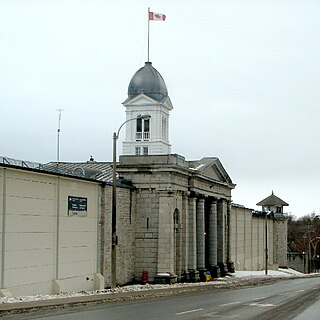
Kingston Penitentiary is a former maximum security prison located in Kingston, Ontario, Canada, between King Street West and Lake Ontario.

A Nissen hut is a prefabricated steel structure originally for military use, especially as barracks, made from a 210° portion of a cylindrical skin of corrugated iron. It was designed during the First World War by the Canadian-American-British engineer and inventor Major Peter Norman Nissen. It was used also extensively during the Second World War and was adapted as the similar Quonset hut in the United States.

Barracks are buildings used to accommodate military personnel and quasi-military personnel such as police. The English word originates from the 17th century via French and Italian from an old Spanish word barraca 'soldier's tent', but today barracks are usually permanent buildings. The word may apply to separate housing blocks or to complete complexes, and the plural form often refers to a single structure and may be singular in construction.
HM Prison Fairlea was an Australian female prison located on Yarra Bend Road in the suburb of Fairfield, Victoria, Australia. The first all-female prison in Victoria, it was built on the site of the Yarra Bend Asylum, with remnants of the walls and gates being used in the layout of the prison. In 1982 a deliberately lit fire led to the deaths of three inmates. The rebuilt and expanded prison reopened in 1986. After closing in 1996 due to privatisation of sections of the prison system, Fairlea was demolished and the site converted to parkland.
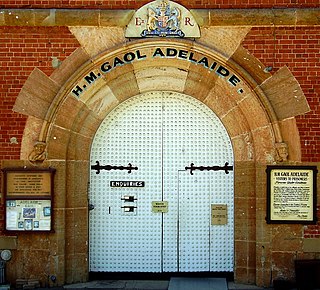
Adelaide Gaol is a former Australian prison located in the Park Lands of Adelaide, in the state of South Australia. The gaol was the first permanent one in South Australia and operated from 1841 until 1988. The Gaol is one of the two oldest buildings still standing in South Australia, the other being Government House which was built at the same time. The prison is now a museum, tourist attraction and function centre.
Glass house or glass houses may refer to:

The Ministry of Public Security Qincheng Prison is a maximum-security prison located in Qincheng Village, Xingshou, Changping District, Beijing in the People's Republic of China. The prison was built in 1958 with aid from the Soviet Union and is the only prison belonging to China's Ministry of Public Security. The Ministry of Justice operates other non-military prisons.

The Caseros Prison was a panopticon prison in Parque Patricios, a neighborhood in the southern part of Buenos Aires, Argentina.

Aldershot Garrison, also known as Aldershot Military Town, is a major garrison in South East England, between Aldershot and Farnborough in Hampshire. The garrison was established when the War Department bought a large area of land near the village of Aldershot, with the objective of establishing a permanent training camp for the Army. Over time, this camp grew into a military town and continues to be used by the Army to the present day. It is home to the headquarters of the Army's Regional Command and Home Command, and it is also the headquarters for the Army Special Operations Brigade. The garrison plays host to around 70 military units and organisations.

HM Prison Northallerton was a prison in Northallerton, North Yorkshire, England. It operated from 1788 until December 2013. During that time, it variously housed male and female adult prisoners, women with children, youth offenders, and military prisoners. Latterly Her Majesty's Prison Service struggled to keep the old prison operating to modern standards, and citing the costs of doing so and the relatively small size of the institution, it closed the prison in 2014. The prison was bought by Hambleton District Council, which is currently redeveloping the site.
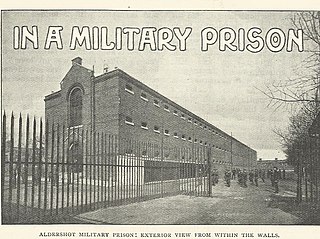
A glasshouse, or the glasshouse is a military prison in the United Kingdom.

HMP Shepton Mallet, sometimes known as Cornhill, is a former prison in Shepton Mallet, Somerset, England. When it closed in 2013, it had been the United Kingdom's oldest operating prison, following the closure of HMP Lancaster Castle in 2011. Before closure, Shepton Mallet was a category C lifer prison holding 189 prisoners. The prison building is Grade II* listed, while the former gatehouse and perimeter walls are Grade II.
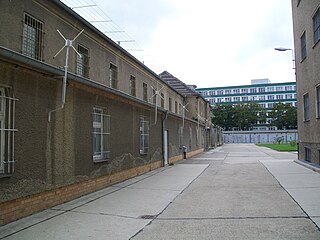
The Berlin-Hohenschönhausen Memorial is a museum and memorial located in Berlin's north-eastern Lichtenberg district in the locality of Alt-Hohenschönhausen, part of the former borough of Hohenschönhausen. It was opened in 1994 on the site of the main political prison of the former East German Communist Ministry of State Security, the Stasi.
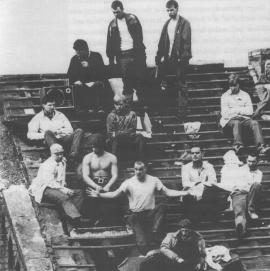
The 1990 Strangeways Prison riot was a 25-day prison riot and rooftop protest at Strangeways Prison in Manchester, England. The riot began on 1 April 1990 when prisoners took control of the prison chapel, and quickly spread throughout most of the prison. The incident ended on 25 April when the final five prisoners were removed from the rooftop. One prisoner was killed during the riot, and 147 prison officers and 47 prisoners were injured. Much of the prison was damaged or destroyed, with the cost of repairs coming to £55 million. It was the longest prison riot in British penal history.

The Montana State Prison is a men's correctional facility of the Montana Department of Corrections in unincorporated Powell County, Montana, about 3.5 miles (5.6 km) west of Deer Lodge. The current facility was constructed between 1974 and 1979 in response to the continued degeneration of the original facility located in downtown Deer Lodge.

The County Gaol, situated in North Parade, Monmouth, Wales, was Monmouthshire's main prison when it was opened in 1790. It served as the county jail of Monmouthshire and criminals or those who fell foul of the authorities were hanged here until the 1850s and some 3,000 people viewed the last hanging. The jail covered an area of about an acre, with a chapel, infirmary, living quarters and a treadmill. It was closed in 1869. In 1884 most of the building was demolished, and today nothing remains but the gatehouse which is a Grade II listed building. Within the gatehouse, there exists "a representation in coloured glass of the complete original buildings". It is one of 24 buildings on the Monmouth Heritage Trail.
The British Columbia Penitentiary was a federal maximum security prison located in New Westminster, British Columbia, Canada. The BC Penitentiary operated for 102 years, from 1878 until it was decommissioned in 1980. It was the first federal penal institution west of Manitoba. The Gatehouse was sold on September 8, 2021.
The history of Fremantle Prison, a former Australian prison in Fremantle, Western Australia, extends from its construction as a prison for convicts, using convict labour, in the 1850s, through to its modern-day usage as a tourist attraction. The design for Fremantle Prison was based on the Pentonville Prison in Britain, and it would be the longest, tallest prison cell block in the southern hemisphere. Construction began in 1851, and was completed by the end of 1859. The prison was transferred to the colonial government in 1886 for use for locally sentenced prisoners. Following a Royal Commission held in 1898−99, some changes were made to Fremantle Prison, including knocking down the inner wall between two cells, introducing a prisoner classification system, and constructing internal walls in the main block to create four separate divisions. A new cell block, New Division, was completed in 1907 and occupied in 1908.
Combined Services Detailed Interrogation Centre is a heritage-listed former military building at 9 Lambert Road, Indooroopilly, City of Brisbane, Queensland, Australia. It was built from 1942 to 1943 by Queensland Main Roads Commission. It is also known as Allied Translator and Interpreter Section headquarters, Northern Command Provost Company headquarters, and Witton Barracks. It was added to the Queensland Heritage Register on 14 October 2016.

The Columbus City Prison was a municipal prison in Downtown Columbus, Ohio. The building was constructed in 1879 in a castle-like style, designed by architect George H. Maetzel. The building served as a prison and headquarters of the Columbus Police Department until a fire demolished the structure in 1920.